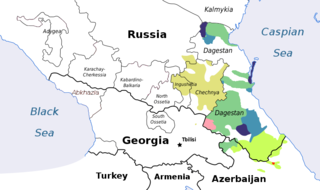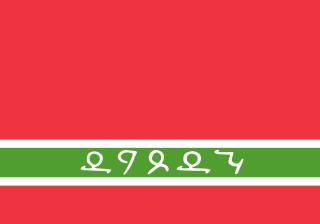
The Northeast Caucasian languages, also called East Caucasian, Nakh-Daghestani or Vainakh-Daghestani, or sometimes Caspian languages, is a family of languages spoken in the Russian republics of Dagestan, Chechnya and Ingushetia and in Northern Azerbaijan as well as in Georgia and diaspora populations in Western Europe and the Middle East. According to Glottolog, there are currently 36 Nakh-Dagestanian languages.

The North Caucasian languages, sometimes called simply Caucasic, is a proposed language family consisting of a pair of well established language families spoken in the Caucasus, predominantly in the north, consisting of the Northwest Caucasian family and the Northeast Caucasian family. There are some 34 to 38 distinct North Caucasian languages.
In phonetics, ejective consonants are usually voiceless consonants that are pronounced with a glottalic egressive airstream. In the phonology of a particular language, ejectives may contrast with aspirated, voiced and tenuis consonants. Some languages have glottalized sonorants with creaky voice that pattern with ejectives phonologically, and other languages have ejectives that pattern with implosives, which has led to phonologists positing a phonological class of glottalic consonants, which includes ejectives.

The palochka or palotchka is a letter in the Cyrillic script. The letter is usually caseless. It was introduced in the late 1930s as the Hindu-Arabic digit '1', and on Cyrillic keyboards, it is usually typeset as the Roman numeral 'I'. Unicode currently supports both caseless/capital palochka at U+04C0 and a rarer lower-case palochka at U+04CF. The palochka marks glottal(ized) and pharyngeal(ized) consonants.

Lezgins are a Northeast Caucasian ethnic group native predominantly to southern Dagestan, a republic of Russia, and northeastern Azerbaijan, and speak the Lezgin language. Their social structure is firmly based on equality and deference to individuality. Lezgin society is structured around djamaat and has traditionally been egalitarian and organised around many autonomous local clans, called syhils (сихилар).
Lezgin, also called Lezgi, is a Northeast Caucasian language. It is spoken by the Lezgins, who live in southern Dagestan (Russia); northern Azerbaijan; and to a much lesser degree Turkmenistan; Uzbekistan; Kazakhstan; Turkey, and other countries. It is a much-written literary language and an official language of Dagestan. It is classified as "vulnerable" by UNESCO's Atlas of the World's Languages in Danger.

Dagestan, officially the Republic of Dagestan, is a republic of Russia situated in the North Caucasus of Eastern Europe, along the Caspian Sea. It is located north of the Greater Caucasus, and is a part of the North Caucasian Federal District. The republic is the southernmost tip of Russia, sharing land borders with the countries of Azerbaijan and Georgia to the south and southwest, the Russian republics of Chechnya and Kalmykia to the west and north, and with Stavropol Krai to the northwest. Makhachkala is the republic's capital and largest city; other major cities are Derbent, Kizlyar, Izberbash, Kaspiysk, and Buynaksk.
Rutulians, Rutuls, also known as the Rutul people are a Northeast Caucasian ethnic group native to Dagestan and adjacent parts of Azerbaijan. According to the 2021 Russian census, there were 34,259 Rutuls in Russia. The Rutul language is a member of the Northeast Caucasian language family; its speakers often have a good command of Azeri and Russian, as Rutul was not a written language until 1990. The Rutul culture is close to that of the Tsakhur and other peoples who inhabit the basin of the upper reaches of the Samur River. Most of the Rutuls are engaged in cattle breeding, farming, and gardening.

The peoples of the Caucasus, or Caucasians, are a diverse group comprising more than 50 ethnic groups throughout the Caucasus.

Tabasarans are a Northeast Caucasian ethnic group native predominantly to southern part of the North Caucasian republic of Dagestan. Their population in World is about 190,000. They speak the Tabasaran language.

Archi is a Northeast Caucasian language spoken by the Archis in the village of Archib, southern Dagestan, Russia, and the six surrounding smaller villages.
Azerbaijanis in Russia or Russian Azerbaijanis are people of Azeri descent in Russia. These may be either ethnic Azeris residents in the country or recent immigrants who profess Azeri ancestry.
Aghul is a Northeast Caucasian language spoken by the Aghuls in southern Dagestan, Russia and in Azerbaijan. It is spoken by about 29,300 people.
Tsakhur is a Northeast Caucasian language spoken by the Tsakhurs in northern Azerbaijan and southwestern Dagestan (Russia). It is spoken by about 11,700 people in Azerbaijan and by about 10,600 people in Russia. The word Tsakhur derives from the name of a Dagestani village where speakers of this language make up the majority.

Rutul or Rutulian is a language spoken by the Rutuls, an ethnic group living in Dagestan (Russia) and some parts of Azerbaijan. It is spoken by 30,000 people in Dagestan and 17,000 in Azerbaijan. The word Rutul derives from the name of a Dagestani village where speakers of this language make up the majority.
The Intercontinental Dictionary Series is a large database of topical vocabulary lists in various world languages. The general editor of the database is Bernard Comrie of the Max Planck Institute for Evolutionary Anthropology, Leipzig. Mary Ritchie Key of the University of California, Irvine is the founding editor. The database has an especially large selection of indigenous South American languages and Northeast Caucasian languages.

The Tabasaran Principality or Principality of Tabasaran was an independent monarchic state in southern Dagestan, existing from 1642 until the later 19th century. It emerged as one of many smaller states from the disintegration of the Shamkhalate of Gazikumukh in 1642. It was located in the Samur river valley, roughly coinciding with the region in which the Tabasaran people still reside today. Its location close to the main road between Derbent and Shirvan gave it some strategic importance.










